The Rice Terraces of the Cordilleras
Sunday, March 13th, 2011 in: News, Travel
The winding road intermittently jostled me awake as the bus weight shifted from side to side, sending people and objects careening off each other. The levers for adjusting the seats were bare metal rods, seemingly filed to a point, which dug into the back of my thigh if I relaxed too much, but all things considered the ride wasn’t that unpleasant. The waning moon partially illuminated the passing world outside the bus; ghostly figures, storefronts and vehicles rushed by, leaving a fuzzy afterimage of the details I could make out through the fog and movement. Occassionally, wide empty expanses opened up to hint at the majestic view, robbed from us through our diurnal evolution. I glanced at my phone: 1:27am, which means we’d already spent about 5 hours on the road, long ago passing the highest elevation point in the Filipino highway system. I stuffed my headphones into my ears and fueled my sparse dreams with Jack Johnson melodies.
We arrived at Banaue just before 6am in a bank of mist and fog, but if the bus hadn’t stopped we wouldn’t have noticed. A guide was already waiting for us just off the bus, and ushered us into a tricycle cab for an obnoxiously short ride that took less time than it took to place my backpack on the back of the bike. We discussed the possible courses to take, and our guide, Antony convinced us to rent a Jeepney to the Saddle, walk to Batad and back, then drive to Bangaan. It seemed like a rather pitiful course considering the expense and effort we took in getting here, and I began to wonder if it was really worth it to cone to Banaue. The guesthouse restaurant soon filled up, making me wish I’d waited to see if we could team up with anyone to cut the expense, but everyone had different plans for their time in the rice fields. The haphazard way the tours and transportation were a reminder that this was still in a way a frontier for cultural rubbernecking, and the locals were capitalizing on the poor tourist infrastructure, or lack thereof.
A couple hours of rest, and we met back in the guesthouse restaurant for some breakfast before heading out. We were unable to find anyone with similar schedules, so it would just be the two of us in the jeepney to the saddle. In retrospect, 2500 pesos is a trifling sum, but considering the prices to which I’d grown accustomed, renting your own jeepney and guide for a day seemed like a major luxury. It felt awfully empty in the back of the jeepney by ourselves. The road outside of Banaue quickly dissolved into a muddy mess straddling the mountainside, overlooking the steep stairway of terraced gardens. With each bounce of the jeepney, we grew ever more grateful we didn’t have to walk in this muck. It took over an hour to get to the Saddle Junction, where the even steeper, muddier road to the Saddle splits off from the road to Bangaan and other small villages with their own rice terraces. Our destination was Batad, the site of some of the largest and most picturesque terraces, close to Tappiyah waterfalls. Had we the time, we would have preferred to trek in and spend the night at Batad, then hike our way back out through the other remote villages. But alas, time was not on our side, so we had to settle for a whirlwind tour of the UNESCO world heritage site. These rice terraces are older than Jesus, and if you were to lay them end to end, they would stretch 20,000 miles.
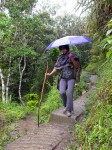 The only road into Batad is a muddy footpath, which is slowly being widened and flattened for wheeled vehicles. As long as the road remains unfinished, the only way in and out of the village is on foot. Almost an hour after jumping off the Jeepney at the Saddle, we reached the vista point and paid a mandatory donation for the preservation of the site. There were several restaurants on top of the hill overlooking the village, which was obscured in a thick mist. I was worried that the journey might be a bust, but when we decided to go down through the terraces to get to Tappiyah falls, the fog lifted and we were rewarded with the sight we’d spent so much time and money to feast our eyes upon. The terraces were truly spectacular, a marvel of ancient human innovation. Our guide was pretty quiet, mostly just showing us the way, but he was able to explain to me how they utilized the terraces to grow rice. Subsistence farming has been going on for thousands of years in this region, but with modern developments, the younger generation is more eager to leave the region and go to work in the cities than carry on the traditional farming methods that sustained their ancestors. Because of this labor shortage the rice terraces produce only a fraction of the area’s needs, whereas it’s capable of producing more than 100% of the region’s needs. Tourism is also quickly becoming a popular industry to work in, but as more young people rely on the terraces for their tourism value, the terraces themselves are getting neglected, and they’re starting to erode. It takes a lot of work to keep them intact, so the industries that rely on their upkeep are hurting more than helping the area.
The only road into Batad is a muddy footpath, which is slowly being widened and flattened for wheeled vehicles. As long as the road remains unfinished, the only way in and out of the village is on foot. Almost an hour after jumping off the Jeepney at the Saddle, we reached the vista point and paid a mandatory donation for the preservation of the site. There were several restaurants on top of the hill overlooking the village, which was obscured in a thick mist. I was worried that the journey might be a bust, but when we decided to go down through the terraces to get to Tappiyah falls, the fog lifted and we were rewarded with the sight we’d spent so much time and money to feast our eyes upon. The terraces were truly spectacular, a marvel of ancient human innovation. Our guide was pretty quiet, mostly just showing us the way, but he was able to explain to me how they utilized the terraces to grow rice. Subsistence farming has been going on for thousands of years in this region, but with modern developments, the younger generation is more eager to leave the region and go to work in the cities than carry on the traditional farming methods that sustained their ancestors. Because of this labor shortage the rice terraces produce only a fraction of the area’s needs, whereas it’s capable of producing more than 100% of the region’s needs. Tourism is also quickly becoming a popular industry to work in, but as more young people rely on the terraces for their tourism value, the terraces themselves are getting neglected, and they’re starting to erode. It takes a lot of work to keep them intact, so the industries that rely on their upkeep are hurting more than helping the area.
Batad is a small village nestled into the valley surrounded by picturesque stone-walled terraces. A few guest houses and restaurants have opened up to cater to the passing tourist population, but for the most part, the village carries on its daily affairs as it has for thousands of years. Our guide, decked out in flip flops, flood pants, a sweatshirt and an umbrella, led us on a trail that took us through the elementary school and peoples’ backyards, past small waterfalls and ultimately into the rice terraces themselves. We had to traverse the terraces, walking along the stone walls to get to the other end where the waterfall was. We saw the river once we crested the ridge on the opposite side of the fields, and had to descend all the way down to the water’s edge before rounding the corner. The entire time we could hear the roar of the waterfall echoing off the mountainside.
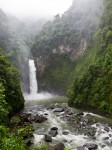 Tappiyah Waterfall is a pretty impressive column of water, roughly 30 or 40 meters tall and gushing however many thousands of gallons of water a minute. Our guide was pretty quiet, mainly because he didn’t really know anything about it. Fortunately a German couple arrived with an animated guide who was more than happy to share her knowledge of the falls, including stories of hapless swimmers and cliff divers who underestimated its power, and paid the ultimate price for their hubris. Our lazy guide stood back and smoked a cigarette; it was unlikely that he was taking any notes on how to do his job better. I hiked up to get a closer view of the falls, and got soaked in the powerful spray.
Tappiyah Waterfall is a pretty impressive column of water, roughly 30 or 40 meters tall and gushing however many thousands of gallons of water a minute. Our guide was pretty quiet, mainly because he didn’t really know anything about it. Fortunately a German couple arrived with an animated guide who was more than happy to share her knowledge of the falls, including stories of hapless swimmers and cliff divers who underestimated its power, and paid the ultimate price for their hubris. Our lazy guide stood back and smoked a cigarette; it was unlikely that he was taking any notes on how to do his job better. I hiked up to get a closer view of the falls, and got soaked in the powerful spray.
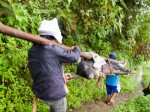 We trudged back out of the valley and back across the terraces, stopping a few times to get a last glimpse of the world heritage site before the mist enveloped it once again. On the way back up, a group of villagers was carrying down a live pig. Apparently, someone in the town had died, and the pig was an offering and a feast for the bereaved. Another interesting fact I learned about burial rites was they don’t embalm the body at all, leaving it in a simple casket for several days before the casket is hoisted up and paraded through the town. The decomposing body has become bloated, and is by now leaking “juices,” which are considered to be “lucky” by the locals. So as the casket is being carried around, people will come up to catch the dripping juices from the coffin and rub themselves with it. It all sounds very sanitary and scientific; the more juices you get and the worse you smell the luckier you are. Hm.
We trudged back out of the valley and back across the terraces, stopping a few times to get a last glimpse of the world heritage site before the mist enveloped it once again. On the way back up, a group of villagers was carrying down a live pig. Apparently, someone in the town had died, and the pig was an offering and a feast for the bereaved. Another interesting fact I learned about burial rites was they don’t embalm the body at all, leaving it in a simple casket for several days before the casket is hoisted up and paraded through the town. The decomposing body has become bloated, and is by now leaking “juices,” which are considered to be “lucky” by the locals. So as the casket is being carried around, people will come up to catch the dripping juices from the coffin and rub themselves with it. It all sounds very sanitary and scientific; the more juices you get and the worse you smell the luckier you are. Hm.
We got back to the saddle quite soaked from the mud, mist, and sweat, despite our best efforts to wear waterproof gear. My shoes took days to dry out, and I’m still looking for ways to get the stink of the Cordilleras out of them. Nevertheless, despite the hassle of getting there, the expense involved, and the mediocrity of our tour guide, I still have to recommend this site to visitors. It really was an amazing place to be, and my only regret was I didn’t have more time to explore the rice terraces of the surrounding area. If you do plan on going to Banaue and are in shape enough to do some trekking, give yourself at least two days, but ideally three or four and you’ll really get your money’s worth. One day is a real whirlwind tour, and you barely skim the surface. Also, be wary of the touts and the “guides,” sometimes they’re just locals walking you around, and aren’t very knowledgeable. I’d rather get lost on my own than pay someone to awkwardly walk around next to me for a day.
We got back to the guesthouse just before it got dark, and realized that Banaue had its own rice terraces, and our guesthouse had a great view that was obscured by the morning fog. Wet and exhausted from the day’s adventures, we were grateful to finally be sleeping in our own beds and not a night bus for the first time in three nights.

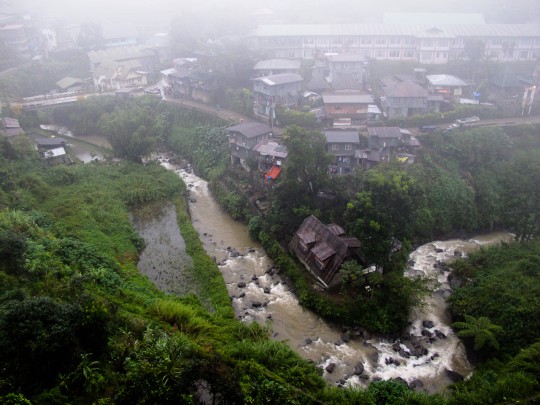
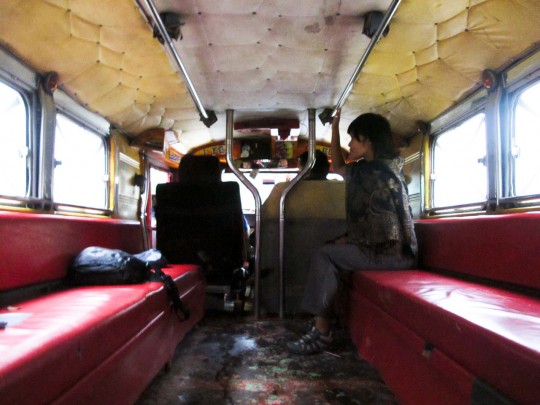
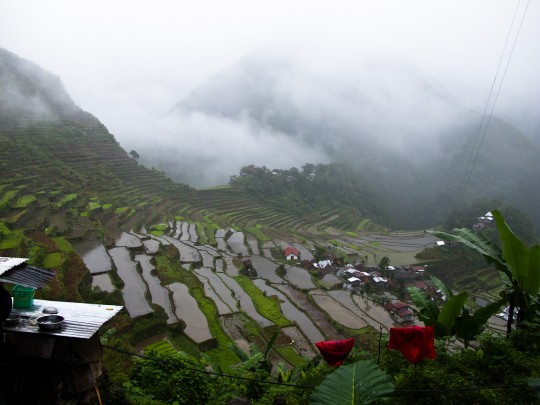
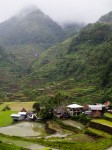
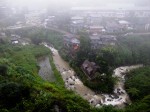
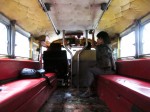
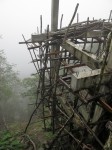

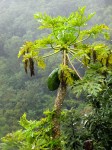
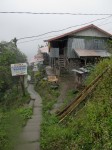

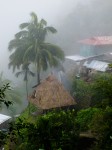
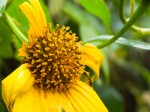
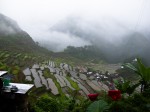
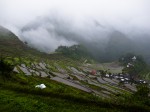
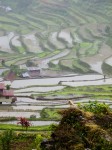
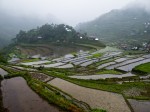
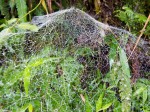
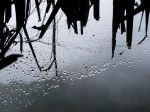
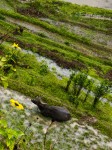
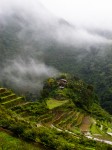

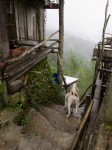
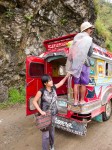
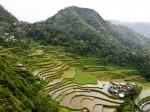
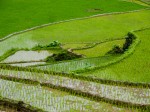
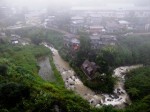







David, thanks it’s like being there. I just wish you had stayed in japan a little longer so I could read about the earthquake and tsunami .
too bad you were in such a hurry, looks amazing. soggy, but amazing